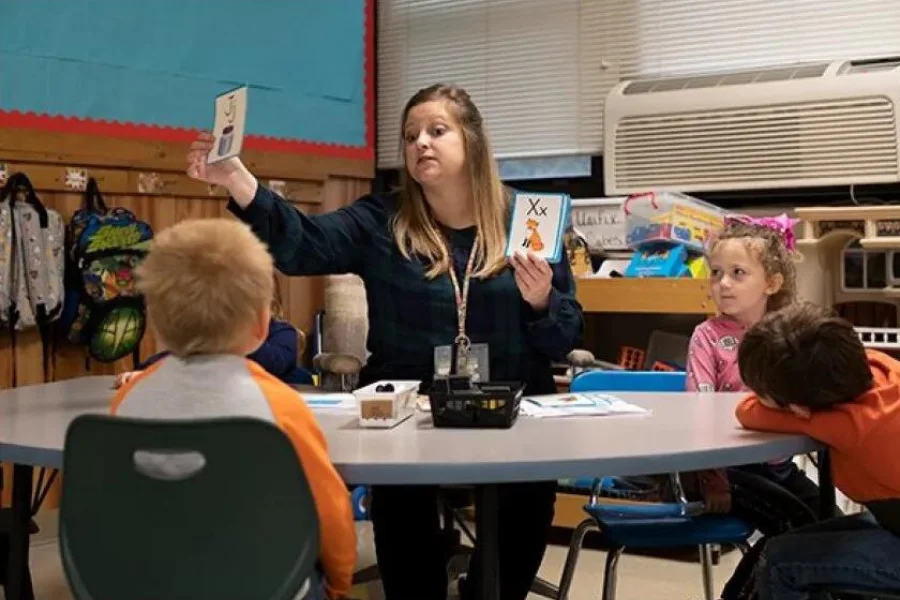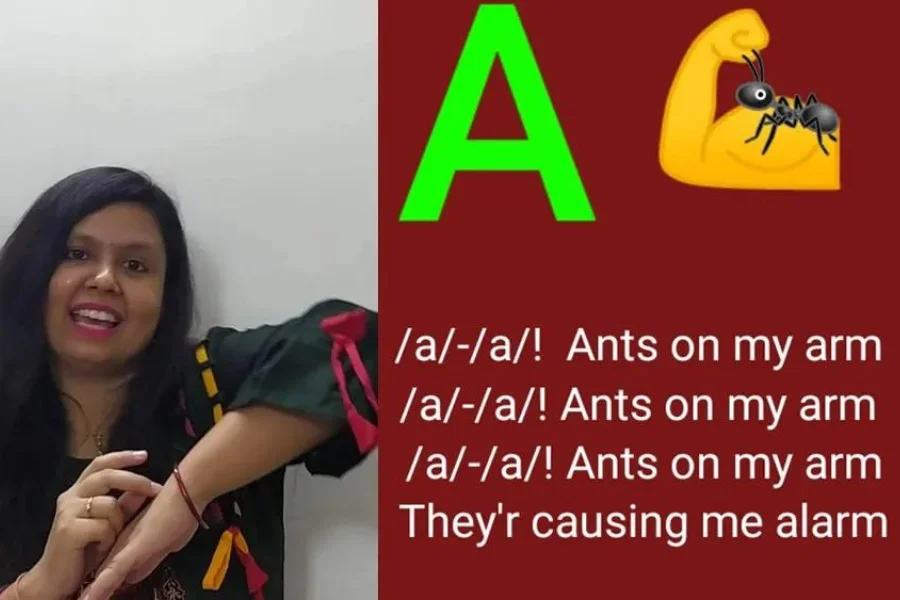Learning Phonics Sounds

Source: freepik
Learning Phonics Sounds
Learning Phonics Sounds helps build a robust foundation for reading by introducing how letters and sounds work jointly. It starts with comprehending letter-sound correspondences, where each letter and letter combination has a specific sound. As vowels can alter how words are pronounced depending on their placement, recognizing vowel sounds is crucial.
Learning Phonics Sounds also involves segmenting and blending, which permits learners to split words into sounds and put them back together to read fluently. Practicing these skills through phonics songs and easy word exercises makes the learning process interesting and effective.
For details of Phonics Teacher Course, Call/Whatsapp on +919869866277 / +919869546913.
Click Here, to download the brochure of Phonics Teacher Course!
Table of Content

Source: edweek
Activities to Teach Phonics Sounds?
Making learning fun is one of the Best Ways to Teach Phonics Sounds effectively. Engaging activities help children recognize letter sounds, blend words, and build reading confidence.
Here are some creative Activities to Teach Phonics Sounds? and reinforce phonics skills:
I Spy
A simple game where children recall objects that start with a distinct sound. For example, “I spy something that starts with the ‘d’ sound.”
Phonics Bingo
Create bingo cards with letters or word families. Call out a sound, and children mark the matching letter or word.
Hopscotch
Draw a hopscotch grid with letters or word chunks. Kids jump to a square and say the sound or blend it with another to form a word.
Phonics Songs
Songs with repetitive sounds help children remember letter-sound relationships while making learning enjoyable.
Word Walk
Scatter letter or word cards on the floor. Children step on a card, say the sound, and use it in a word.
Phonics Dice
Roll a die with letters or sounds on each side, and children say a word that begins with or includes that sound.
Word Ladder
Begin with an easy word, change one letter at a time, and form new words (e.g., “sat” → “bat” → “bit” → “bin”).
Letter Pong
Label cups with letters or sounds. Kids toss a ball into a cup and say a word using that letter or sound.
These practical exercises not only make learn Phonics Sounds interesting but also help Teach Phonics Sounds in a way that supports their reading skills naturally.
How to Teach Phonics at Home?
Assisting children to learn to read starts with a strong foundation in phonics. If you’re wondering How to Teach Phonics, focus on letter-sound relationships, blending sounds, and using interactive activities.
Here are some simple ways to Teach Phonics at Home:
Use Flashcards
Introduce letters and their sounds with simple flashcards. Use picture flashcards to help children associate sounds with familiar objects. Choose flashcards with illustrations to make letter sounds easier to remember.
Play Phonics Games
Balloon Phonics – A fun way to practice three-letter words.
I Spy – Say, “I spy something that begins with…” and use the sound instead of the letter.
Letter Hunt – Make a list of letters or sounds and find them on signs, billboards, license plates, etc.
Encourage Reading
Read books that match your child’s phonics level to reinforce learning. Choose engaging stories with simple words to build confidence.
Other Helpful Activities
Develop phonemic understanding by helping children listen to and play with sounds in words. Familiarize them with phonics patterns and rules to boost word recognition. Practice word breakdown, decoding, and blending sounds to form words.
By using a combination of reading, games, and practical activities, you can Start Phonics Teaching in a way that makes Learn Phonics Sounds enjoyable and effective.

Source: maloointernationalschool
How to Learn A- Z Phonics Sounds?
Learning Phonics Sounds is a significant step in building strong reading skills. If you’re wondering How to Learn A- Z Phonics Sounds, focusing on letter-sound connections, repetition, and interactive activities can make the process of Learning Phonics effective and enjoyable.
Here are some key steps to follow:
Introduce Each Letter Sound Individually
Start with simple sounds, such as “a” as in apple, “b” as in ball, and “c” as in cat. Emphasize clear pronunciation to help with sound recognition.
Use Visual Aids
Flashcards with pictures help associate each letter with its corresponding sound. Label common objects with their beginning sounds to reinforce learning.
Practice Repetition
Say each letter sound multiple times and encourage the learner to repeat after you. Daily practice makes Learning Phonics easy and helps strengthen memory and recall.
Incorporate Phonics Songs and Chants
Songs that include alphabet sounds make learning fun and engaging. Repetitive melodies help reinforce phonics concepts.
Blend Sounds to Form Words
Once individual sounds are familiar, start blending them to form words. Begin with simple words like “cat” (c-a-t) and “dog” (d-o-g).
Play Phonics Games
Try “Sound Hunt,” where the learner finds objects that start with a specific sound. Use letter puzzles or matching games to reinforce sound-letter connections.
By following these steps, Learning Phonics Sounds becomes a fun and interactive experience. Whether using songs, games, or visual aids, these methods help learners to effectively grasp How to Learn A- Z Phonics Sounds?
How to Start Teaching Phonics?
Phonics is a key step in helping children develop robust reading skills. If you are wondering How to Start Teaching Phonics, it begins with familiarizing letter sounds, blending words, and using interactive methods to keep learning entertaining. Whether you wish to Teach Phonics at Home or in a classroom, the right approach makes a big difference.
Steps to Start Phonics Teaching:
Introduce Letter Sounds
Teach one letter at a time, beginning with commonly used sounds like “s,” “a,” and “t.” Using flashcards, pictures, or real objects will help children in connecting letters with sounds making Learning Phonics Sounds easy .
Use Phonics Songs and Stories
Songs with repetitive sounds help reinforce learning. Read simple books that focus on phonetic patterns to build confidence.
Practice Blending and Segmenting
Show how to blend letter sounds to form words, such as “c-a-t” → “cat.” Encourage segmenting, where children break words into individual sounds.
Play Interactive Phonics Games
Games like “I Spy,” letter hunts, and phonics bingo make Learning Phonics Sounds fun. Use phonics dice or word-building activities to practice new sounds.
A structured Phonics Course can help parents and educators to effectively Teach Phonics at Home. Vidhyanidhi Education Society (Govt. Regd.) offers a Phonics Teacher Training Course that provides in-depth knowledge and teaching strategies to Start Phonics Teaching.
By following these steps, anyone can Start Teaching Phonics and assist children in Learning Phonics Sounds engagingly and effectively. Learning Phonics Sounds is a gradual process, and with the right approach, children develop strong reading skills that last a lifetime.
Join Vidhyanidhi Education Society’s Phonics Teacher Course today!
For details of Phonics Teacher Course, Call/Whatsapp on +919869866277 / +919869546913.
Click Here, to download the brochure of Phonics Teacher Course!
FAQs
What Age is good for Phonics?
Phonics learning typically begins around ages 3-4 with letter sounds and progresses to blending words by ages 5-6.
How successful is Phonics?
Phonics is highly effective in teaching reading, improving word recognition, spelling, and comprehension, especially when introduced early.




